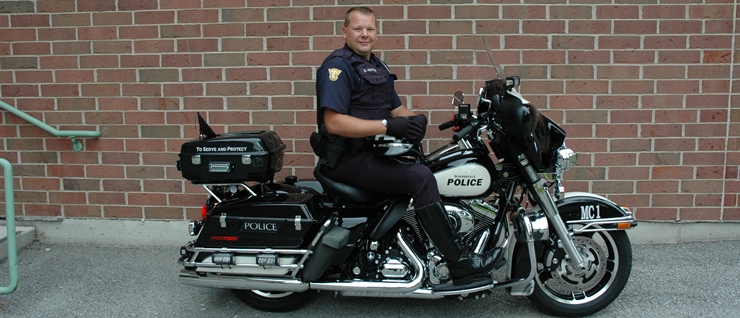The Schererville Police Department currently has one 2009 Harley Davidson motorcycle Police Classic. The new purchase of a Police motorcycle costs between $12,000 – $14,000, with an additional cost of $3,000 to outfit it with equipment such as a police radio and radar. Without the gracious financial assistance of the community, the motorcycle program would probably not exist.
The Schererville motorcycle program started in 1927. Town Marshall Pete Redar, to whom a park is named after, rode a Harley Davidson which was purchased from Harry Molenar of Molenar Harley Davidson in Hammond, Indiana.
Former Police Superintendent Ben Blake re-initiated the motorcycle patrol in 1988. At that time Superintendent Blake assigned Lieutenant Michael Ison to the traffic division. Lieutenant Ison was sent to Florida and became certified to ride and subsequently became an instructor for the Schererville Police Department. Since that time period, Sergeant Brian Vandenburgh and Corporal Brian Neyhart were both trained by Lieutenant Ison who rode a Harley Davidson for our agency.
In 1996, Police Chief Donald Parker assigned the motorcycle to Officer Buc Weaver. Officer Weaver attended an intense 2 week course that was offered by Northwestern University Traffic Institute and the Harley Davidson Motor Company. This course is required to become a Schererville Motorcycle Officer.
Our current 2009 Police Motorcycle was purchased from Calumet Harley Davidson, in Munster, Indiana. MC#1 is black/white in color.

As you may be aware there are many benefits to having police officers on motorcycles. Due to its size, a motorcycle can easily maneuver in and out of heavily congested traffic and construction zones during emergencies. Also a very important feature is the cost. Equipping a police vehicle may run up to $30,000 compared to $13,000 for a police motorcycle. Another large factor is fuel and maintenance. Police motorcycles are far less expensive than the average patrol car.
In the town of Schererville we have many parks, which, along with the bike patrol, a police motorcycle can easily get in, allowing it to maneuver around a crowd or respond to an emergency fast and efficiently.
Motorcycle Tips and Laws
- Preparing to ride
- Wear the right gear.
- Become familiar with the motorcycle.
- Check the motorcycle equipment prior to riding.
- Be a responsible rider.
- Clothing: The right clothing protects you in a collision
- Jackets and pants should cover arms and legs completely. They should fit snugly enough to keep from flapping in the wind, yet loosely enough for you to move freely.
- Boots or shoes should be high and sturdy enough to cover your ankles and give them support.
- Gloves allow a better grip and help protect your hands in a crash. Your gloves should be made of leather or a similar durable material.
- Some common law requirements for motorcyclists
- I.C. 9-24-8-4: Requirement for and privileges of a learner’s permit
- The operator must hold a valid operator’s, chauffeur’s, or public passenger chauffeur’s license first.
- The individual must pass a written examination developed by the bureau of motor vehicles, concerning the safe operation of a motorcycle. A motorcycle learner’s permit authorizes the permit’s holder to operate a motorcycle upon a highway during a period of 1 year, under the following conditions:
- The holder of the learner’s permit must wear a helmet approved by the Department of Transportation.
- The motorcycle can only be operated in daylight hours.
- The motorcycle does not carry passengers other than the operator.
- I.C. 9-21-10-9: Protective headgear and face shields for drivers under 18 years of age.
- If a person who is less than 18 years of age is operating or riding motorcycle on the streets or highways, the person shall wear the following.
- Protective headgear meeting the minimum standards set by the bureau of motor vehicles.
- Protective glasses, goggles, or a transparent face shield.